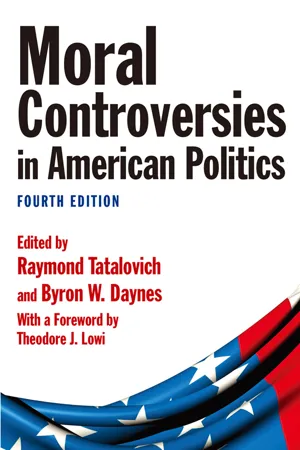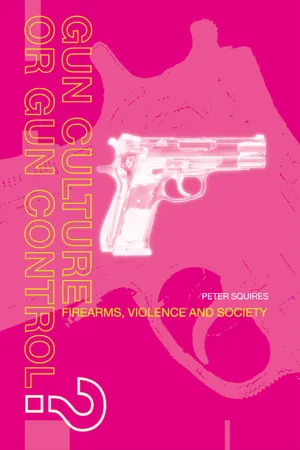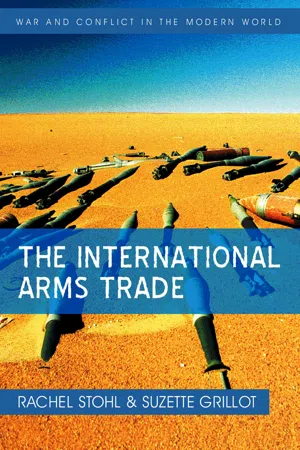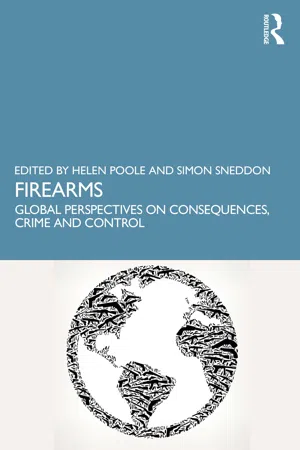Politics & International Relations
Gun Control
Gun control refers to the regulation of the manufacture, sale, and use of firearms. It encompasses various policies aimed at reducing gun violence and ensuring public safety, such as background checks, waiting periods, and restrictions on certain types of firearms. The debate over gun control often revolves around balancing Second Amendment rights with the need to prevent gun-related tragedies.
Written by Perlego with AI-assistance
5 Key excerpts on "Gun Control"
Learn about this page
Index pages curate the most relevant extracts from our library of academic textbooks. They’ve been created using an in-house natural language model (NLM), each adding context and meaning to key research topics.
- eBook - ePub
- Robert J. Spitzer(Author)
- 2017(Publication Date)
- Routledge(Publisher)
17 Although government involvement in some social regulatory policies predates the 1960s (notably crime control), considerable governmental and societal interest has focused on these issues in recent decades as the federal government has moved into this area, spawning intense and even explosive political antagonisms. The political characteristics of Gun Control conform closely to this characterization. But why is Gun Control an issue of social regulation? Or, to rephrase the question, what is it about Gun Control that provokes such sharp, deeply held feelings? What values underlie guns?The Gun Controversy
In order to understand the dynamics of the gun issue, we need to begin with the admittedly narrow common ground of opponents and proponents. Despite the enormous differences that separate Gun Control advocates and opponents, they do share a few common assumptions:- The primary and unique purpose of firearms is to provide an efficient means of destruction of people, animals, and objects. Although some may admire firearms for aesthetic, artistic, sporting, or other qualities, no one can dispute this central purpose of firearms. Indeed, they evolved from the pressures of war during the Middle Ages.18 Other objects in society cause great destruction, of course, ranging from knives to automobiles, but these objects exist or were created to serve other purposes.19 Knives, for example, serve a nearly infinite variety of other purposes; automobiles exist for the primary purpose of transporting people and commodities across vast expanses. The injury, destruction, or death that arises from these or other objects is incidental or at least secondary to the primary and necessary purpose for which they exist. The same cannot be said for firearms, so they are distinctive for this reason alone.
- Existing gun laws have limited effects in curtailing gun-related deaths and injuries nationwide. Gun Control advocates argue that the relative ineffectiveness of gun laws lies with their weakness and the problem of jurisdiction. The vast majority of gun laws exist at state and local levels, and states and cities with tougher gun laws find them at least partly neutralized by the ease with which guns can be transported from areas with weak gun laws. Stronger and more inclusive federal laws could address this problem—whether they could succeed is a separate question—but existing federal regulation is considered both limited and weak, although some Gun Control opponents find even existing law too restrictive. Gun Control opponents argue that government simply cannot succeed in such regulation either for practical reasons—that is, too many Americans already own weapons—or because stronger laws would violate fundamental American values, beliefs, and practices.
- eBook - ePub
- Raymond Tatalovich, Byron W. Daynes, Theodore J. Lowi(Authors)
- 2014(Publication Date)
- Routledge(Publisher)
7a (federalism): Supported, because states had gun laws prior to the first federal Gun Control statute, and gun rights groups continue to press for sympathetic state laws.7b (compliance): Supported, in the sense that the ATF relies on state and local law enforcement authorities as partners in Gun Control enforcement and, given its inadequate resources coupled with congressional prohibitions on ATF monitoring of gun dealers, the implementation of Gun Control policy seemingly relies heavily on voluntary compliance by gun dealers.For Further Insight into the Gun Control Debate
Bowling for Columbine . This 2002 documentary by Michael Moore is a highly critical examination of the American gun culture.Carter, Gregg, ed. Encyclopedia of Guns in American Society . 2 vols. Santa Barbara, CA: ABC-CLIO, 2002. A interdisciplinary compilation of every major aspect of the Gun Control issue.Cornell, Saul. A Well-Regulated Militia . New York: Oxford University Press, 2006. A major study of the origins of the Second Amendment as a civic obligation.DeConde, Alexander. Gun Violence in America . Boston: Northeastern University Press, 2001. A sweeping examination of gun practices and politics from colonial times to the present.Guns and Mothers . This documentary by Sugar Pictures, first aired on PBS on May 14, 2003, examines the Gun Control issue from the perspectives of two women on opposing sides.Kennett, Lee, and James LaVerne Anderson. The Gun in America . Westport, CT: Greenwood Press, 1975. Historical treatment of the role of guns and Gun Control in American development.Spitzer, Robert J. Gun Control: A Documentary and Reference Guide . Westport, CT: Greenwood Press, 2009. A collection of over fifty documents pertaining to the gun issue.———. The Politics of Gun Control , 4th ed. Washington, DC: CQ Press, 2008. A political, policy, and legal analysis of all elements of the Gun Control issue.———. The Right to Bear Arms - eBook - ePub
Gun Culture or Gun Control?
Firearms and Violence: Safety and Society
- Peter Squires(Author)
- 2012(Publication Date)
- Routledge(Publisher)
Having already considered some of the broader debates concerning the emerging ‘gun culture’ as well as some of the more specific questions about alleged ‘loopholes’ in the firearms licensing (and inspection) system, I do not propose to give these issues any more attention here. Furthermore, accepting what appears to be the weight of medical and criminological evidence on predicting the psychological suitability of firearm licence applicants, except to note that various commentators did keep returning to the issue, there seems little further mileage in this question. We now need to consider a number of rather more social-scientific Gun Control arguments. Even here, however, the debate remains highly charged: what campaigners call ‘Gun Control’, many shooters are inclined to call ‘civilian disarmament’. Even discussing the issue of firearms control from the perspective of criminology prompted the response that this is not appropriate because the possession of properly licensed firearms is not a crime and licensed shooters are not criminals. However, accepting these caveats about the contrasting definitions of the issue and the creative extension of criminology’s own brief, we can proceed.As we have seen already, one of the interesting issues in the Gun Control debate developing following the Dunblane massacre was the relative absence of any clear or consistent criminological contributions and the comparative ease with which even those that did emerge were sidelined. What follows, therefore, is less a detailed statistical analysis of rates of firearm ownership and patterns of firearm-related offending than an examination of the contrasting discourses within which the debate itself was largely confined. As Taylor has argued, many participants in the Gun Control debate frequently appear to lack an appreciation of the nature of ‘evidence’ and ‘explanation’ in the contemporary social sciences. Such commentators appear wedded to a rigidly positivistic perspective typical of nineteenth-century scientific thinking. Accordingly they reject any evidence that they believe falls short of demonstrating a strict causal relationship between given factors: for instance, firearm availability in a given society and rates of armed crime (Zimring and Hawkins, 1987; Taylor, 1996, 1998). In this sense, statistical criminology, encounters a very nineteenth-century problem in its analysis of the Gun Control debate – a problem of the ‘missing link’ in a supposed causal chain connecting legal firearms with criminal practices. Given that aggregate social scientific data – of even the most reliable kinds – will seldom provide such definitive proofs, an association between guns and crime will be difficult to demonstrate – perhaps especially to sceptics. - eBook - ePub
- Rachel Stohl, Suzette Grillot(Authors)
- 2013(Publication Date)
- Polity(Publisher)
6 Controlling the international arms tradeIn February 2008, twenty-eight states1 took part in the first session of the UN Group of Governmental Experts on an Arms Trade Treaty. The group was tasked with determining the possible feasibility, scope and parameters of a legally binding international agreement that establishes common international standards for international arms transfers. The initiative marked recognition by the international community that the legal trade in arms has had negative consequences for global peace and security, human rights and development, and marked an evolution of existing control mechanisms covering the conventional weapons trade.Yet, developing an Arms Trade Treaty will not be an easy task. Although many governments have demonstrated increased interest in global arms trade controls, some states – particularly those that have a significant stake in the arms trade, from either a se curity or economic perspective – challenge such undertakings and constrain efforts to limit weapons transfers. When discussing controls, states are constantly mindful of the intersection between foreign policy, security and humanitarian concerns on the one hand, and financial issues such as ‘trade, jobs and profit’ on the other.2 Indeed, throughout history, balancing responsible arms trade practices with security and human rights has always been challenging and has had implications for the ways in which the global weapons trade system is controlled and managed.In general, the international trade in conventional arms has proven to be difficult to control. Unlike weapons of mass destruction (nuclear, chemical and biological weapons), conventional arms are considered legitimate weapons with purposes ranging from national defence and security force use to policing purposes, sport and hunting activities and personal security use. Conventional arms, therefore, are viewed as legitimate commodities that can be fairly sold, provided and traded, making arms control efforts all the more complicated and fraught with obstacles and challenges. Nonetheless, numerous efforts have been made at the international, regional and national levels to control the trade in arms, with varying degrees of success. This chapter provides an in-depth look at theses efforts. It first provides a historical overview of past efforts to control the weapons trade before focusing on more recent arms control activities at the international, regional and national levels. Within the context of these various levels of activities, the chapter discusses the relevant arms control actors and their roles in limiting the arms trade. Finally, the chapter examines the various challenges and obstacles facing arms control today and concludes with a discussion of the prospects for weapons control measures in the future. - eBook - ePub
Firearms
Global Perspectives on Consequences, Crime and Control
- Helen Poole, Simon Sneddon, Helen Poole, Simon Sneddon(Authors)
- 2021(Publication Date)
- Routledge(Publisher)
UK , where most of this book’s authors are located, we experience relatively low levels of firearm crime, and as citizens generally enjoy a fairly secure existence, this is not the case for many communities and regions across the globe. Whether through conflict or the weaponisation of civilians in a society, we have seen briefly in this introduction, how pervasive the impact of firearms can be in societies where various legal, judicial and social control mechanisms are relatively weak. The impact of firearm-related violence is multi-faceted and responding to the challenges that it presents are complex.On the basis of basic economics, the prevalence of firearms in society will require a dual approach of the reduction of both demand and supply at every level. However, unlike some social problems, such as illegal drugs, the firearms challenge is exacerbated and frustrated by the fact that firearms and other small arms and light weapons, are not prima facie illegal: most (about 80–90%) are manufactured legally under state licenses (see Small Arms Survey, 2003 ) and enter the illicit market through a variety of means including corruption, theft and leakage (see Squires, 2014 ). Only a small percentage therefore start life as illegal, that is manufactured by unlicensed actors. However, akin to some other illegal markets, weapons production is often a significant contributor to a number of the world’s economies, including the US, providing an arguable conflict of interest for States to pay serious attention to attempts to reduce supply and demand. Indeed, it is often such States that fail to sign up to treaties and resolutions designed to tighten the control of firearms trade (Bromley et al., 2012).Through the course of this book, the authors address a number of ways in which local, national and international communities are attempting to address this issue, from the role of civil society organisations to the role of international treaties and co-operation. How states respond through legal frameworks and their criminal justice systems are also considered.




